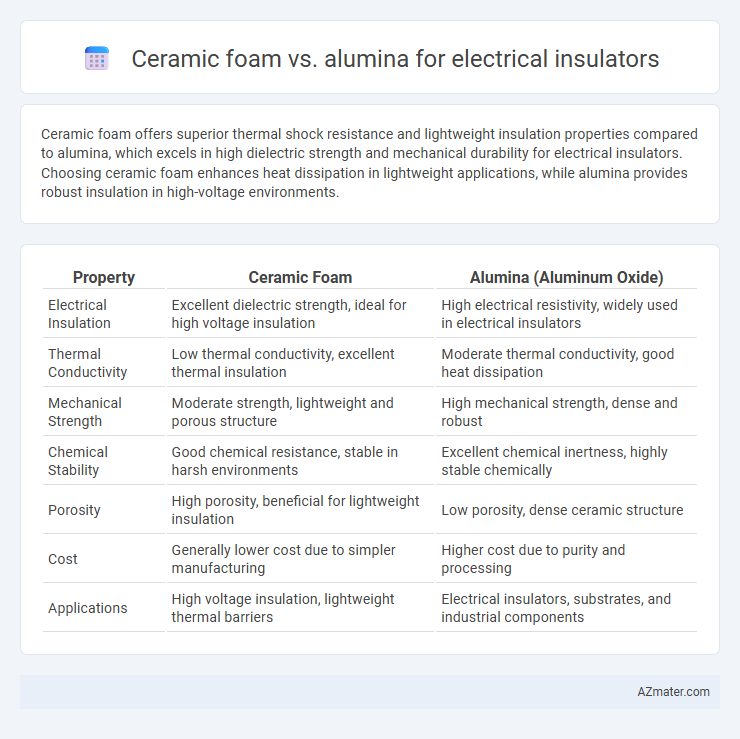Ceramic foam offers superior thermal shock resistance and lightweight insulation properties compared to alumina, which excels in high dielectric strength and mechanical durability for electrical insulators. Choosing ceramic foam enhances heat dissipation in lightweight applications, while alumina provides robust insulation in high-voltage environments.
Table of Comparison
| Property | Ceramic Foam | Alumina (Aluminum Oxide) |
|---|---|---|
| Electrical Insulation | Excellent dielectric strength, ideal for high voltage insulation | High electrical resistivity, widely used in electrical insulators |
| Thermal Conductivity | Low thermal conductivity, excellent thermal insulation | Moderate thermal conductivity, good heat dissipation |
| Mechanical Strength | Moderate strength, lightweight and porous structure | High mechanical strength, dense and robust |
| Chemical Stability | Good chemical resistance, stable in harsh environments | Excellent chemical inertness, highly stable chemically |
| Porosity | High porosity, beneficial for lightweight insulation | Low porosity, dense ceramic structure |
| Cost | Generally lower cost due to simpler manufacturing | Higher cost due to purity and processing |
| Applications | High voltage insulation, lightweight thermal barriers | Electrical insulators, substrates, and industrial components |
Overview of Ceramic Foam and Alumina Insulators
Ceramic foam insulators feature a porous structure that provides excellent thermal shock resistance and lightweight properties, making them ideal for high-temperature electrical insulation applications. Alumina insulators, composed primarily of aluminum oxide (Al2O3), offer superior mechanical strength, high dielectric strength, and excellent chemical stability under harsh environmental conditions. Both materials are widely used in electrical insulation, with ceramic foam favored for thermal management and alumina preferred for robust, long-lasting electrical insulating performance.
Material Composition and Structure
Ceramic foam electrical insulators primarily consist of porous silicon carbide or alumina materials with interconnected voids that reduce thermal conductivity while maintaining mechanical strength. Alumina insulators feature a dense, crystalline structure composed mainly of aluminum oxide (Al2O3), which provides excellent dielectric strength and high thermal stability. The porous structure of ceramic foam offers superior thermal shock resistance and lightweight properties, whereas dense alumina excels in environments requiring high mechanical durability and electrical insulation.
Electrical Insulation Properties
Ceramic foam exhibits excellent electrical insulation properties due to its interconnected porous structure, which significantly reduces thermal conductivity and enhances dielectric strength, making it ideal for high-voltage electrical insulators. Alumina, with its high dielectric constant and superior electrical resistance, offers excellent insulating performance in high-temperature environments but is generally denser and less porous than ceramic foam. The choice between ceramic foam and alumina depends on the specific application requirements, balancing dielectric strength, thermal insulation, and mechanical stability.
Thermal Resistance and Stability
Ceramic foam exhibits superior thermal resistance due to its porous structure, providing excellent insulation and minimizing heat transfer in electrical applications. Alumina offers exceptional thermal stability with a high melting point around 2072degC, maintaining structural integrity under extreme temperatures. While ceramic foam excels in reducing thermal conductivity, alumina is preferred for environments requiring consistent performance at elevated temperatures.
Mechanical Strength and Durability
Ceramic foam offers excellent thermal insulation and lightweight properties but typically exhibits lower mechanical strength compared to dense alumina, which is known for its superior hardness and fracture toughness. Alumina's high mechanical strength ensures better durability under mechanical stress and thermal cycling, making it ideal for demanding electrical insulator applications. The dense microstructure of alumina enhances its resistance to wear and chemical attack, significantly extending the lifespan of electrical insulation components.
Manufacturing Processes Compared
Ceramic foam insulating materials are typically produced through direct foaming, replication, or sintering methods, allowing for lightweight structures with high porosity, enhancing thermal shock resistance and insulating properties. Alumina insulators are commonly manufactured using powder pressing combined with high-temperature sintering, resulting in dense, mechanically robust materials with superior electrical insulation and thermal conductivity. The manufacturing process for ceramic foam emphasizes porosity and structural foams for insulation efficiency, while alumina processing focuses on achieving high-density, high-purity ceramics suitable for demanding electrical insulation applications.
Cost Efficiency and Availability
Ceramic foam offers superior cost efficiency for electrical insulators due to its lower raw material and manufacturing expenses compared to alumina, which is generally more expensive and resource-intensive to produce. Alumina provides higher electrical insulation performance and thermal stability but its availability is limited by the complexity of refining bauxite and processing aluminum oxide. Industries seeking balance often choose ceramic foam for large-scale, cost-sensitive applications, while alumina is preferred for high-performance needs despite its higher cost and limited availability.
Applications in Electrical Engineering
Ceramic foam and alumina are widely used electrical insulators in electrical engineering, with ceramic foam excelling in high-temperature insulation and thermal shock resistance in applications such as high-voltage equipment and power transformers. Alumina offers superior dielectric strength and mechanical stability, making it ideal for insulating components in electrical motors, sensors, and high-frequency devices. Both materials support electrical insulation, but alumina is preferred where precision and durability under electrical stress are critical.
Environmental Impact and Sustainability
Ceramic foam offers superior environmental benefits compared to alumina due to its lightweight structure, which reduces material consumption and energy use during manufacturing. Its porous nature enhances thermal insulation, decreasing energy demand in electrical systems and contributing to sustainability goals. Alumina, while highly durable and thermally stable, requires intensive mining and refining processes that result in higher carbon emissions and environmental degradation.
Choosing the Right Insulator: Key Considerations
Ceramic foam offers superior thermal shock resistance and lightweight properties, making it ideal for high-temperature electrical insulators requiring efficient heat dissipation. Alumina provides excellent electrical insulation with high dielectric strength and chemical stability, suitable for applications demanding robust mechanical strength and long-term durability. Selecting the right insulator involves balancing factors such as operating temperature, mechanical stress, dielectric requirements, and environmental conditions to optimize performance and longevity.

Infographic: Ceramic foam vs Alumina for Electrical insulator
 azmater.com
azmater.com